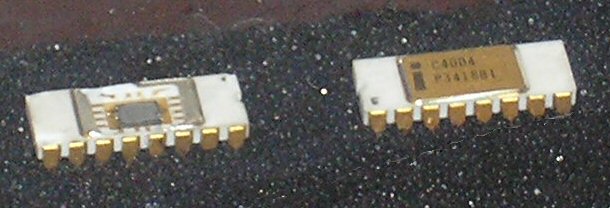I gave some thought to how I might recreate a bootstrap load using the MOSFETs and other components I have on hand. The problem I wrestled with was how to best recreate a MOSFET that looked like a resistor when turned on and not a dead short. Finally I tried a couple of combinations of the BSS83 MOSFET in series with a resistor or two. Finally I settled on a pair of resistors, one between Vdd and the FET's drain and the other between the FET's source and the rest of the circuit.
The gate of Q1 is actively driven high by a 500ns pulse from my trusty PIC, shown here in YELLOW. In a real circuit the drain of Q1 would be the output to the next circuit, depicted in RED. Q2, in concert with R1 and R2 (4.7K), simulate the load FET in the 4004.
My first test was with Q2's gate hard-wired to Vdd as shown above. A purely resistive load would pull all the way to Vdd (5V) in about 750ns, but because the load FET (Q2) starts to turn off as Vgs decreases, this circuit cuts off at 3.7V (Vgs = 1.3V). This is acceptable in most of the 4004's logic circuits, but when this output is intended to drive the gate of a pass transistor it's important for the output (RED) to go as high as possible. In these cases the 4004 uses a "bootstrap load".
In the next circuit I've disconnected Q2's gate from Vdd and put another FET in the path. This FET, Q3, has its gate connected to Vdd, acting as another resistor. Unlike the previous circuit there won't be significant current flow if this FET turns on fully, so I haven't bothered with additional resistors.
As the 'scope traces show, we've
lost about 0.9V of output level. This is because Q2's gate is held at 2.8V instead of 5.0V, as Q3 also turns off as its Vgs drops below its threshold voltage. Why have Q3 at all? Because it's necessary in the next circuit.
Next, I added a 33pF bootstrap capacitor C1 between Q2's gate and the "source" of our simulated load FET. As I explained in
Puzzling out the Bootstrap Load, Q3 will act as a diode, allowing the bootstrap capacitor to charge when the load FET's source is pulled low, but preventing it from discharging when the source is allowed to rise toward Vdd.
Here we see proof that C1 acts like a flying capacitor in a charge pump, keeping Q2's Vgs at about 1.9V (at least initially) even as the output rises all the way to Vdd. Eventually this leaks away and the output drifts down, but it takes quite a long time — long enough for the signals we're trying to pass through the pass transistors to pass with minimal loss.
Just for fun I went one step further and replaced Q3 with a 1N914 fast switching diode. As you can see below, this improves the charge pump efficiency over using the BSS83 MOSFET with Q2's Vgs reaching 3V. Note the vertical scales are are 2V/div in this trace, rather than to 1V/div in the previous traces.
Thus ends the mystery of the Bootstrap Load!









Ken Shirriff has recently written a nice description of the operation of the Bootstrap Load here: https://www.righto.com/2020/10/how-bootstrap-load-made-historic-intel.html
ReplyDelete